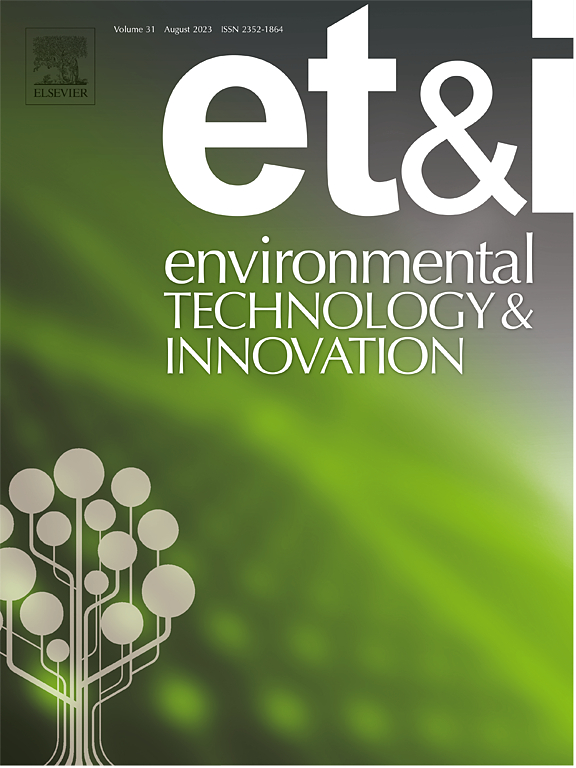Organic management improves soil P availability via increasing inorganic P solubilization in tea plantations
IF 6.7
2区 环境科学与生态学
Q1 BIOTECHNOLOGY & APPLIED MICROBIOLOGY
引用次数: 0
Abstract
Organic management is a crucial practice for activating residual phosphorus (P) and enhancing its availability in soils, with microorganisms playing a central role in regulating P cycling. Despite this, the effects of long-term organic management on P availability via microbial functional traits remain insufficiently explored. This study evaluates the impact of chemical (industrial fertilizers) (CF) and organic fertilization (OF) over an extended period in tea plantations, also incorporating surrounding forestland (FD) for comparison. We analyzed soil properties, P fractions, microbial functional genes, and microbial communities involved in P cycling. Our findings demonstrated that CF and OF both significantly enhanced soil P availability and nutrient levels, with organic management showing a positive correlation with soil available P. Notably, OF significantly decreased the abundance of pstS, phnC, phnD and phnE compared to CF, suggesting the potentially inhibition of P uptake and transport system. Organic management significantly increased gene abundance of ppk1, ppx, aphA and glpA compared to CF, indicating the promotion of soil inorganic P solubilization and organic P mineralization. Different management did not significantly affected the functional genes relative abundance involved in P starvation response regulation. Organic management also markedly increased the abundance of Actinobacteria, Gemmatimonadetes and Chloroflexi, which were markedly positively related to soil available P. This study advances our understanding of the role of soil microbial functional genes and communities in enhancing P availability, elucidating the impacts of organic resources in subtropical tea plantations.
有机管理通过增加茶园中无机磷的溶解来提高土壤磷的有效性
有机管理是激活土壤中残余磷(P)并提高其有效性的关键实践,微生物在调节P循环中起着核心作用。尽管如此,长期有机管理通过微生物功能性状对磷有效性的影响仍未得到充分探讨。本研究评估了化学(工业肥料)(CF)和有机施肥(of)对茶园长期的影响,并结合周围林地(FD)进行比较。我们分析了土壤性质、磷组分、微生物功能基因和参与磷循环的微生物群落。结果表明,有机肥和有机肥均显著提高了土壤磷素有效性和养分水平,有机管理与土壤速效磷呈显著正相关。与有机肥相比,有机肥显著降低了pstS、phnC、phnD和phnE的丰度,表明有机肥可能抑制了土壤磷素的吸收和转运系统。有机管理显著提高了土壤中ppk1、ppx、aphA和glpA基因丰度,促进了土壤无机磷的溶解和有机磷的矿化。不同管理对磷饥饿反应调控相关功能基因的相对丰度影响不显著。有机管理还显著提高了放线菌、双胞菌和绿氟菌的丰度,并与土壤速效磷呈显著正相关。本研究促进了对土壤微生物功能基因和群落在提高土壤速效磷中的作用的认识,阐明了有机资源对亚热带茶园土壤速效磷的影响。
本文章由计算机程序翻译,如有差异,请以英文原文为准。
求助全文
约1分钟内获得全文
求助全文
来源期刊

Environmental Technology & Innovation
Environmental Science-General Environmental Science
CiteScore
14.00
自引率
4.20%
发文量
435
审稿时长
74 days
期刊介绍:
Environmental Technology & Innovation adopts a challenge-oriented approach to solutions by integrating natural sciences to promote a sustainable future. The journal aims to foster the creation and development of innovative products, technologies, and ideas that enhance the environment, with impacts across soil, air, water, and food in rural and urban areas.
As a platform for disseminating scientific evidence for environmental protection and sustainable development, the journal emphasizes fundamental science, methodologies, tools, techniques, and policy considerations. It emphasizes the importance of science and technology in environmental benefits, including smarter, cleaner technologies for environmental protection, more efficient resource processing methods, and the evidence supporting their effectiveness.
 求助内容:
求助内容: 应助结果提醒方式:
应助结果提醒方式:


